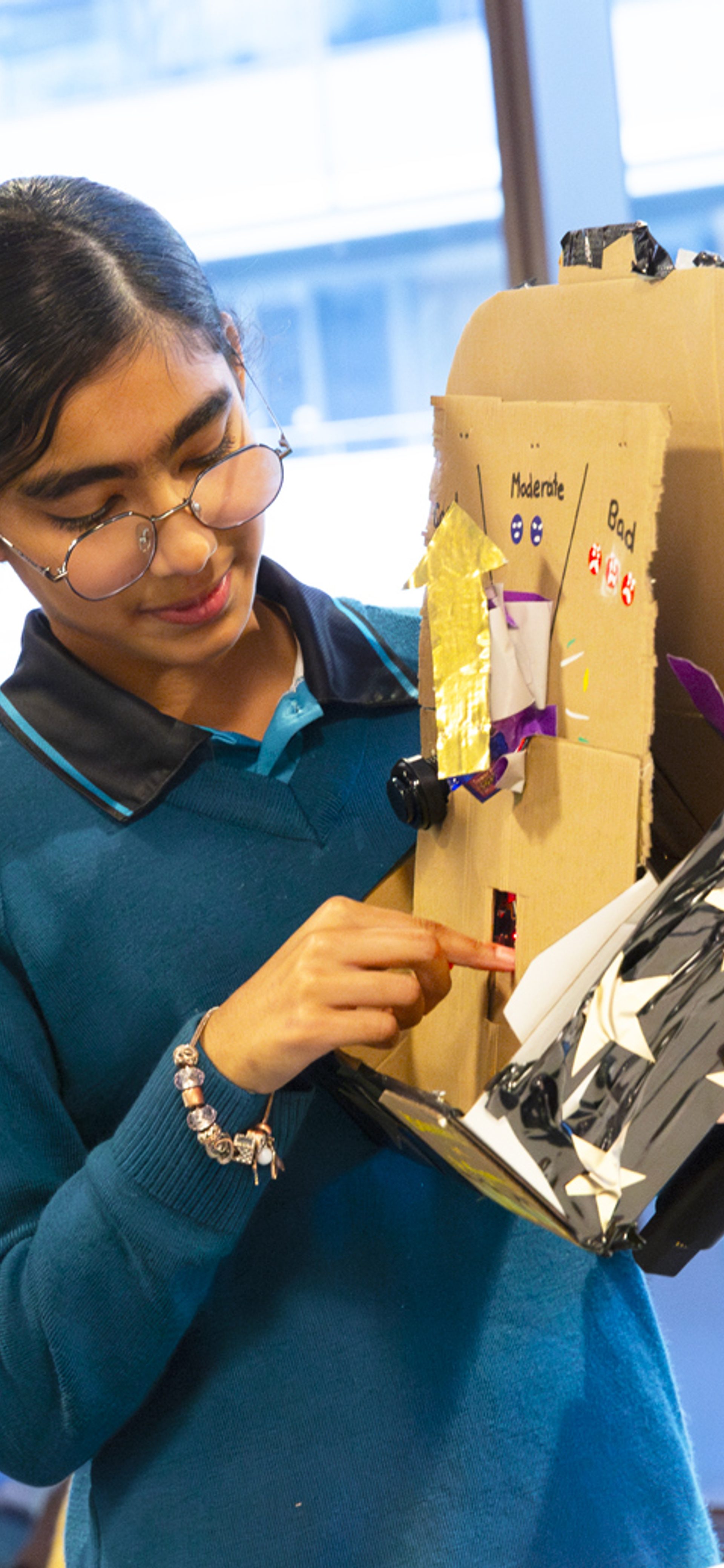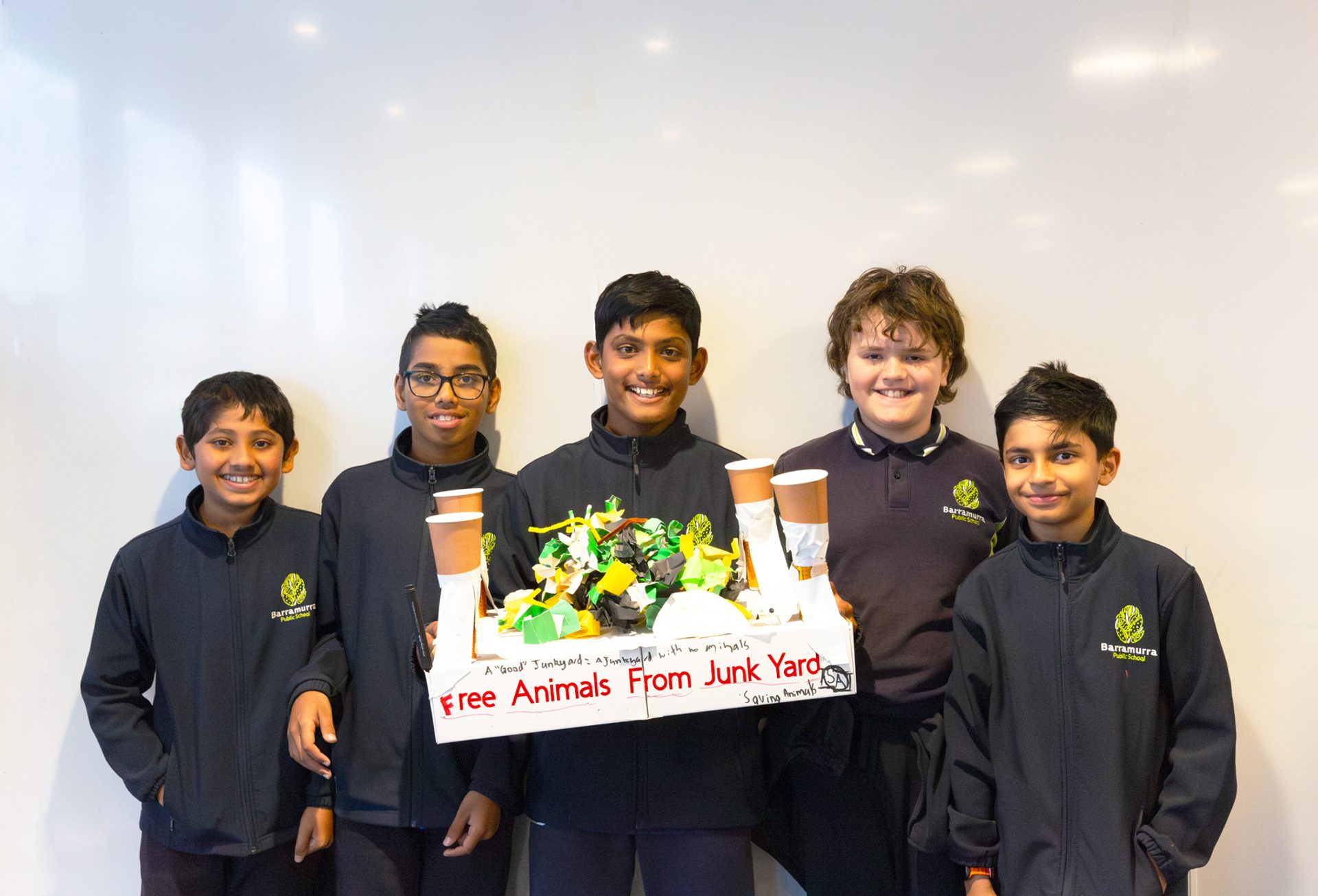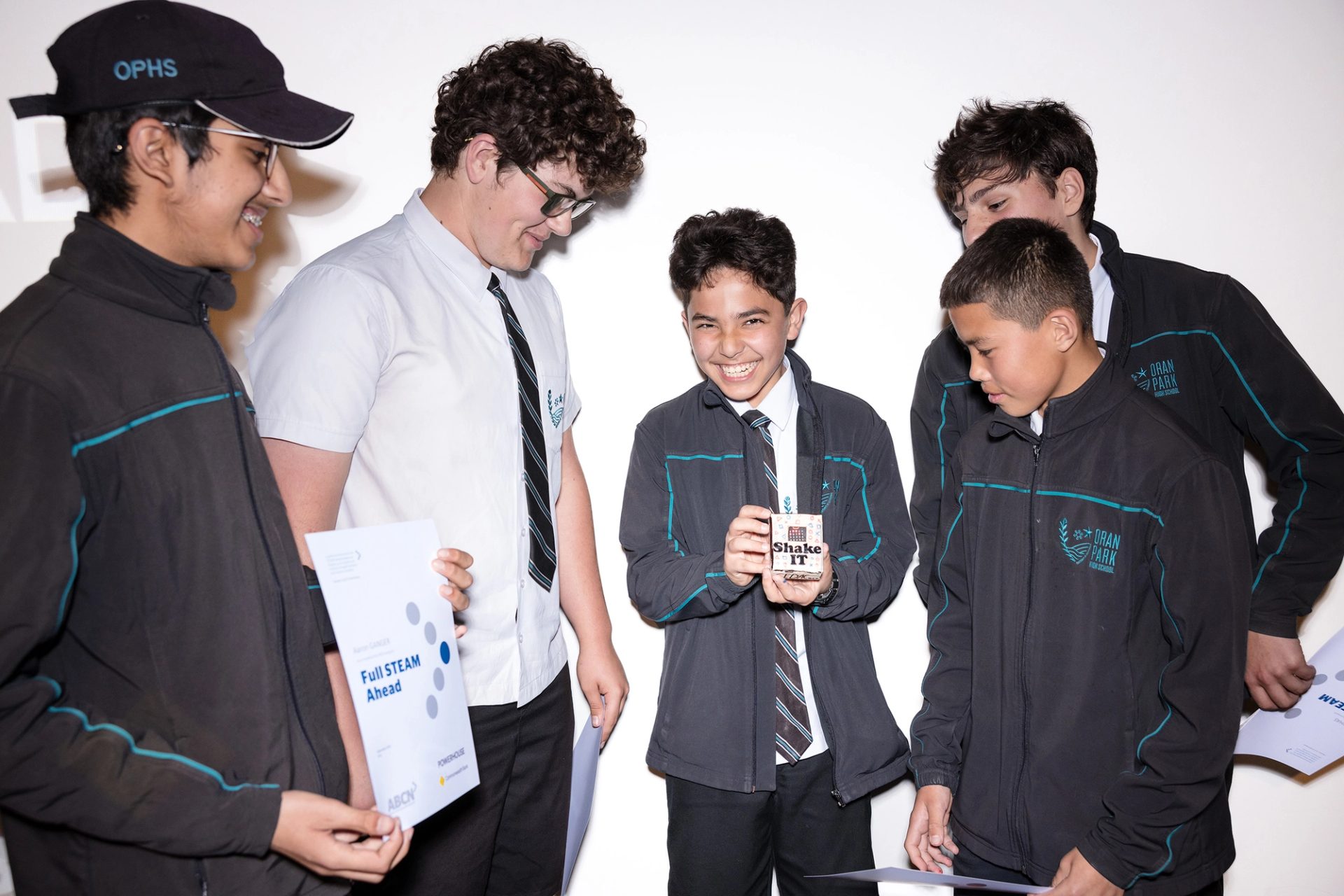Full STEAM Ahead 2024

‘The design process in the first workshop was really fun, the Powerhouse coding was also enjoyable and being an engineer for the last session was extremely fun, cutting out and adding bits of craft.’
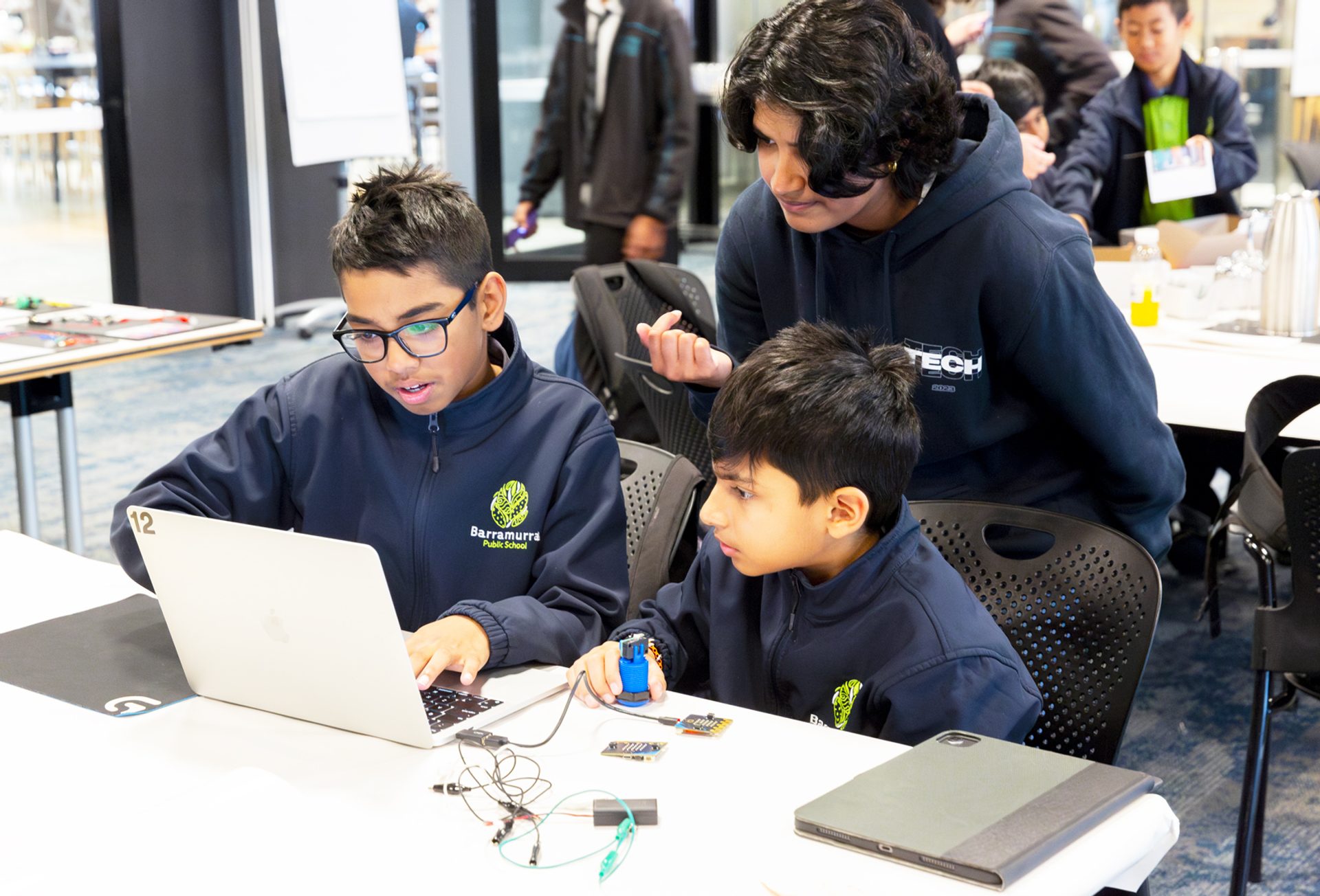
Full STEAM Ahead is an annual program aimed at inspiring and encouraging young people in school years 5–8 to pursue studies and future career ambitions across Science, Technology, Engineering, Arts and Mathematics (STEAM). This engaging and fun 3-week learning program is a partnership project between the Australian Business Community Network (ABCN), Powerhouse Learning and Commonwealth Bank of Australia.
In week one the young participants meet their Commonwealth Bank mentors who share personal experiences of STEAM career pathways. Together, they explore the power of design thinking to tackle real-world issues and the positive actions young people can take. They also experiment with new technologies such as Virtual Reality.
‘I learnt about the amount of skills which go into working with coding. This includes teamwork, dedication, productive thinking and creativity.’
‘Watching the students open up and work together towards a common goal. Seeing them change from the “giggles” table to completing the tasks ahead and being organised and proud of their work.’

In week two the participants visit the museum, where Powerhouse educators lead a series of coding workshops, supporting the development of computational thinking, problem-solving and physical computing skills.
In the final week the young people exploit their new STEAM skills, knowledge and confidence, working together to respond to a self-directed design challenge. Teams identify a real-world need, designing and building prototype solutions using a pocket-size BBC micro:bit computer and external components such as motors, arcade buttons and LEDs.
In 2024 Full STEAM Ahead reached 150 young people aged 9–14 from primary and high schools across South Western Sydney, including Barramurra Public School, Greenway Park Public School, Hoxton Park High School, John Edmondson High School, Kingsgrove North High School, Kingswood High School, Merrylands High School and Oran Park High School.
2024 PROJECTS
The following projects were coded and constructed in under two hours, demonstrating the young people’s strong collaboration, innovation, creativity and problem-solving skills.
Greenway Park
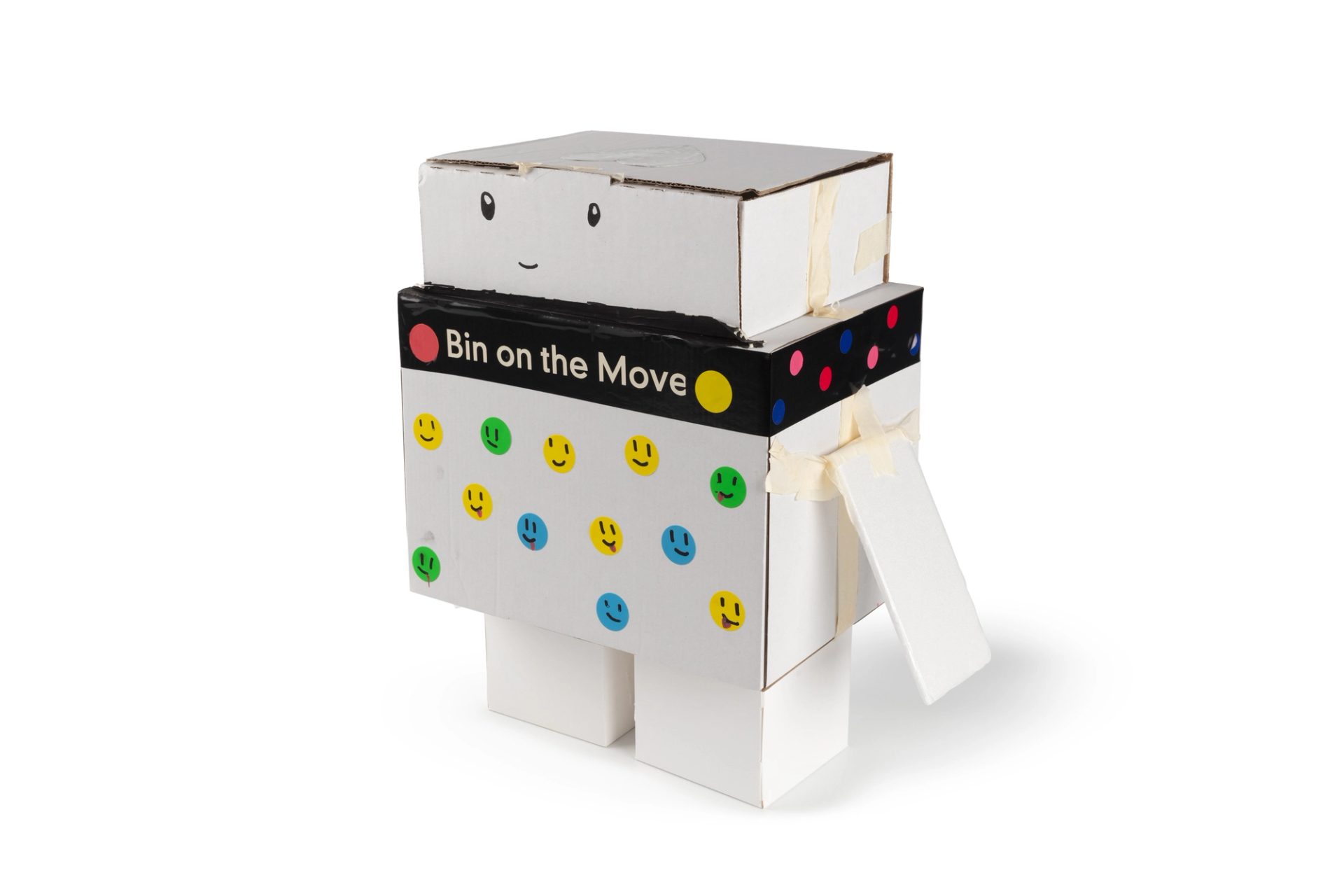
Bin on the Move
The problem we are trying to solve is ‘How might we reduce waste in the community?’ Bin on the Move has a vacuum to suck up any rubbish on the floor, charges itself, has green, yellow and red lights to show its battery level and two compartments, one on the back that empties rubbish into a bigger bin. This bin is aimed at students in class, but other public areas eventually. The bin does not make any sound so it doesn’t interrupt anyone.
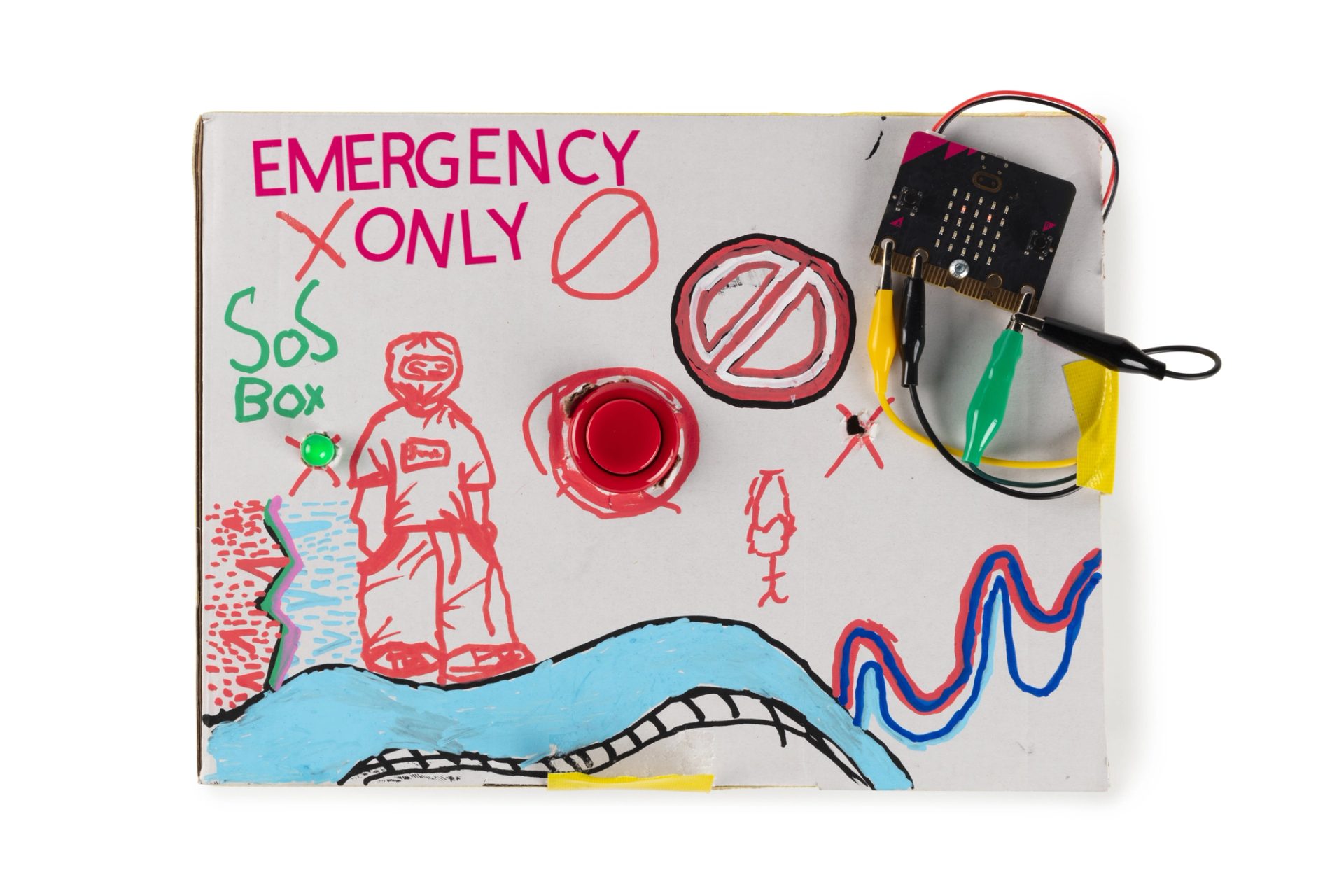
SOS Box
Our customers are any elderly people who need help. The SOS box is trying to solve the problem of people being injured while moving. When the button on the box is pressed, the lights turn on, a sound plays and a picture displays on the Micro:bit. The final product we would develop from this is a bracelet or watch with a button for signalling for help, contacting 000 or calling family.
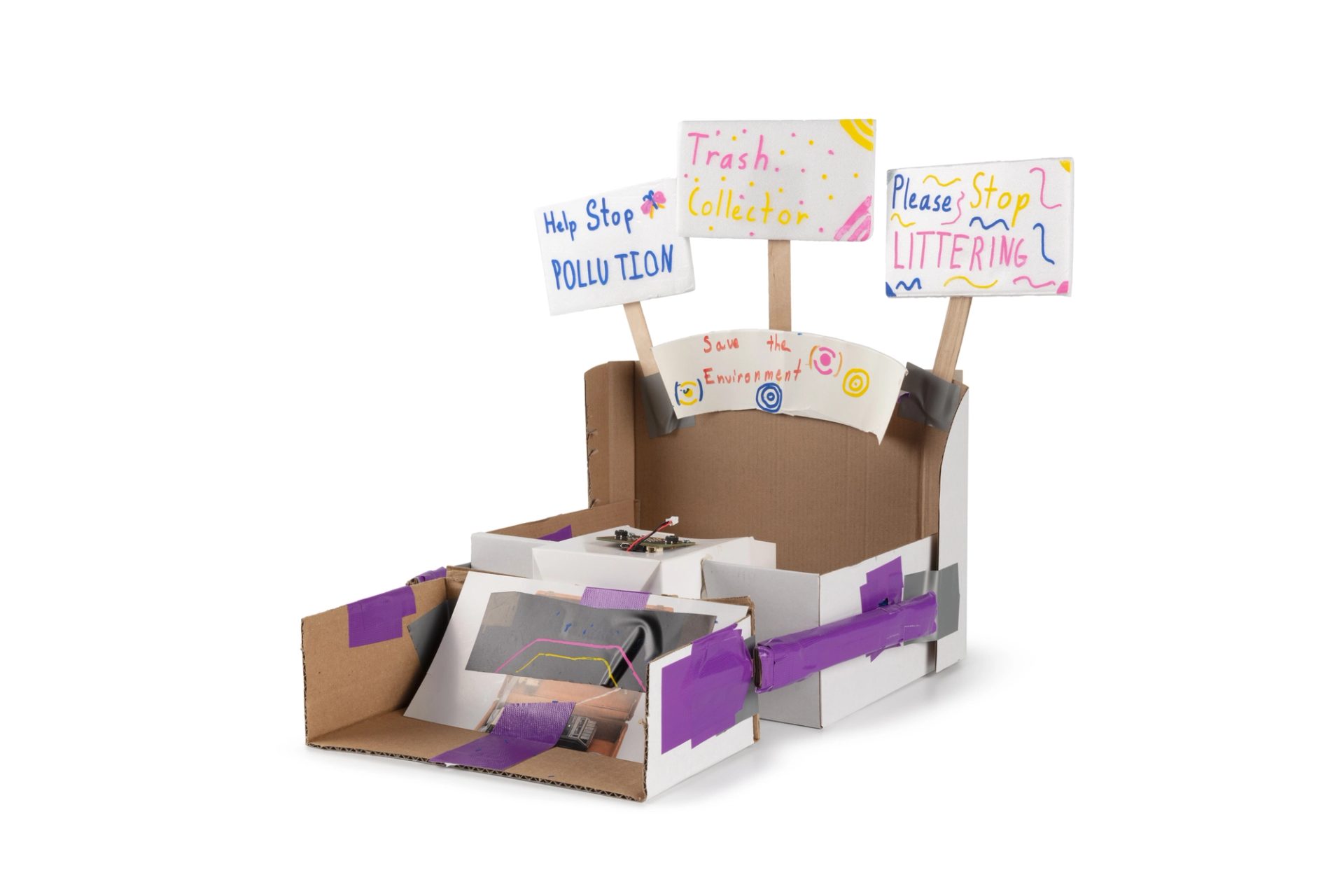
Eco Friendly Trash Box Grabber
Our product is a way to help stop people from littering. The Eco Friendly Trash Box Grabber is a robot that picks up trash with motor functions to lift a scoop. This invention helps the environment by cleaning up trash.
John Edmonson High School
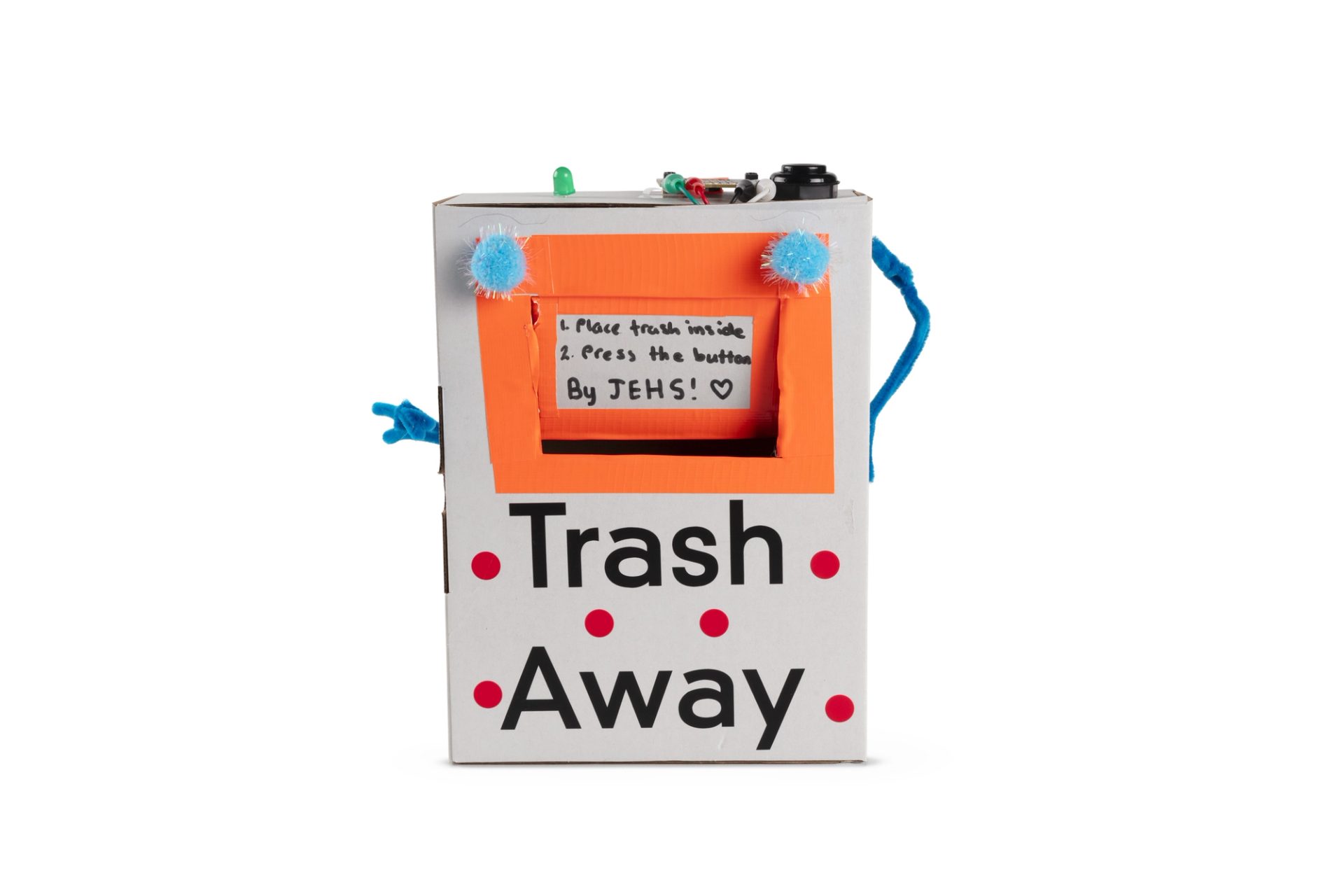
Trash Away
We are trying to solve the problem of ‘How might we reduce trash in the school playground?’ Our product, Trash Away works by placing trash inside, then pressing the button on top. Once complete you will be rewarded with a smiling face and a vibrant green light. This project makes it a fun way to discard trash. It shows the good of people in the community in a fun way! If we had more time, we would add a sensor to the flap to make it automatic.
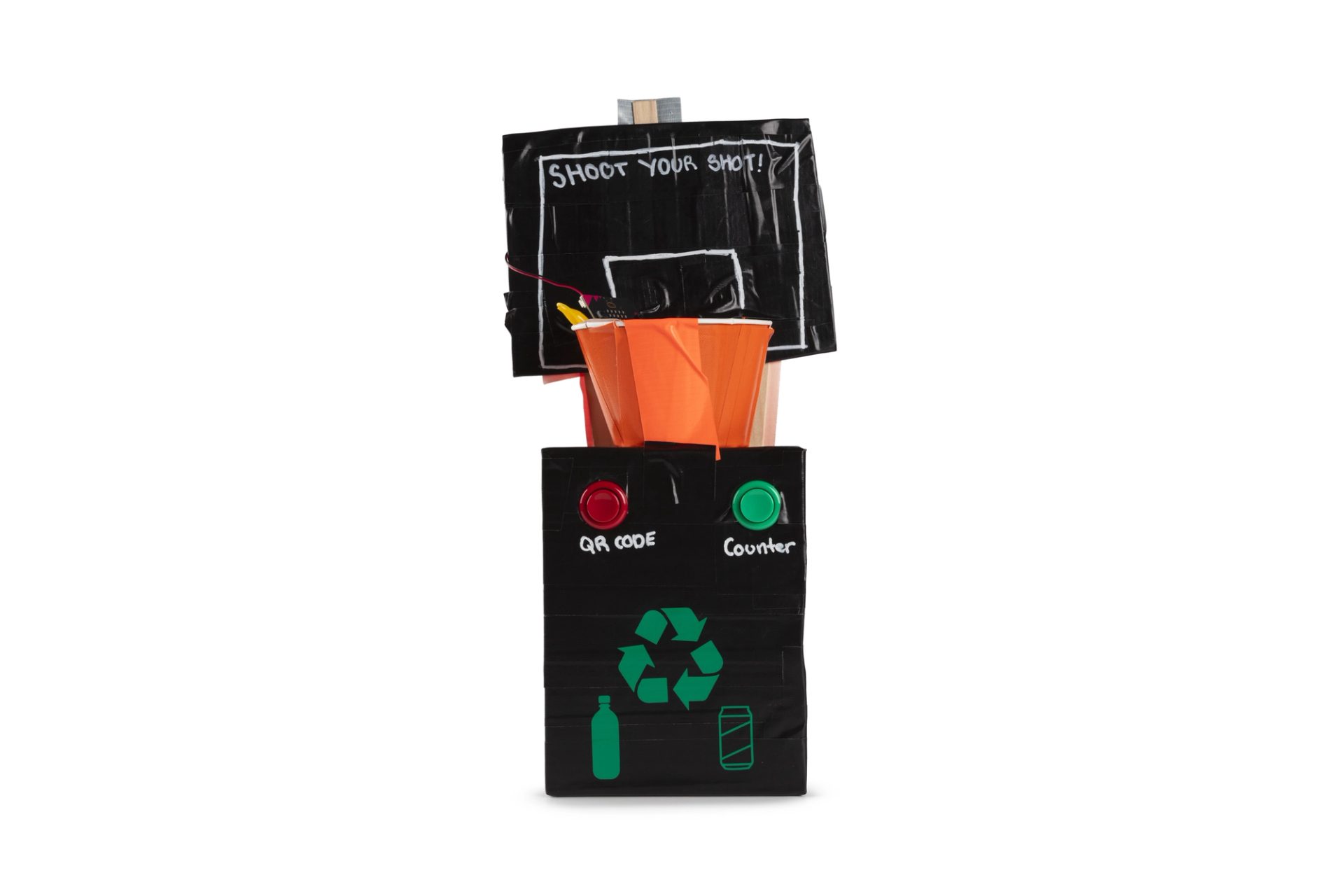
Shoot your shot
Shoot Your Shot makes throwing your rubbish away more fun and easier, while giving the user a reward. It reduces littering by making recycling fun for all ages. The reward for throwing your rubbish away is money which can be claimed at your local supermarket using the code given. The green button is the counter, you double click it to count your score. Clicking the red button gives you your code, which you take to your local supermarket.

Autto Bin
The problem we are trying to solve is ‘How might we reduce food waste and litter in our community?’ This product is designed to be easy to access and practical to use. It is a portable miniature bin that you can carry by hand with the handles or in a bag. Having pleasing aesthetics, it encourages people to throw their trash away. Autto Bin for the win!

Ready Set Throw
Ready Set Throw helps solve the problem of how we might reduce waste/litter in our local community. Our project is a bin that displays light and phrases based on its capacity. The Micro:bit is placed inside and connected to external lights; when the Micro:bit is covered, the light turns on. The lights indicate how full it is and the different colours encourage people to use the bin and guide people to the nearest empty bin. This prevents overflowing bins, leading to a cleaner environment. In the actual model, the lights would be a large screen and only display the colours when the bin has reached a certain capacity.
Hoxton Park High School

Project Noise
This project is used by students and teachers, helping them to communicate with each other, while keeping the voice level in the classroom low to learn better. Button A will send a sign saying the student needs to go to the bathroom. Button B will also send a sign, a triangle signaling for help. We decided to make this idea because without talking much, you can focus better, learn better and it works for people who are too shy to speak. A problem we faced was the challenging coding and different computer ideas. We also had multiple designs varying from colourful to plain.
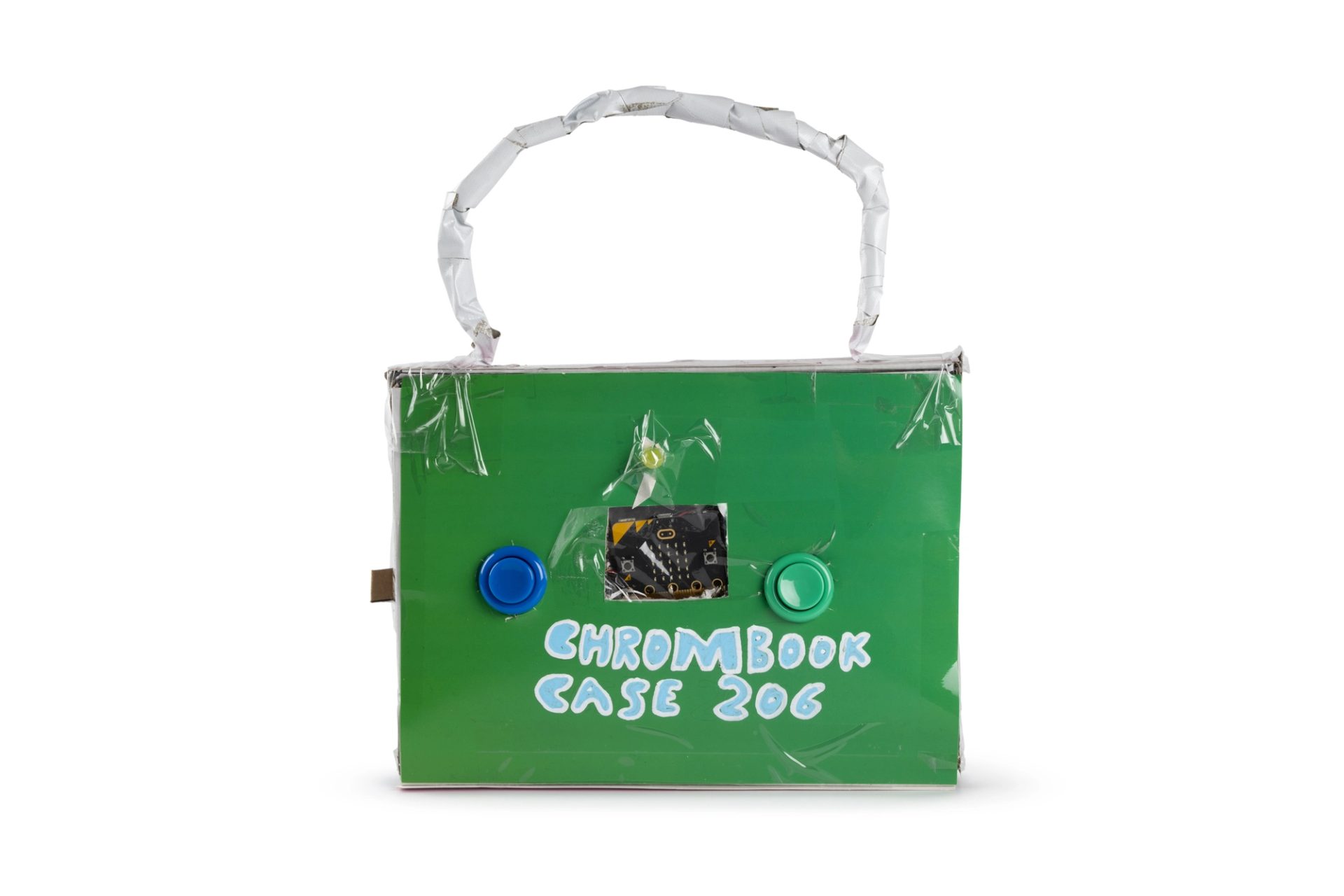
Chromebook Case 206
We have created a Chromebook case to improve our school laptop quality and performance. We figured out there were lots of mechanical difficulties with our school Chromebooks. For example, the audio in the Chromebooks is very low and very glitchy. Sometimes, the screens are cracked and the keyboard keys are broken. To fix these problems, we used cellophane for the screen protector. We have also provided a small cardboard box for the pen, to hold it in place.
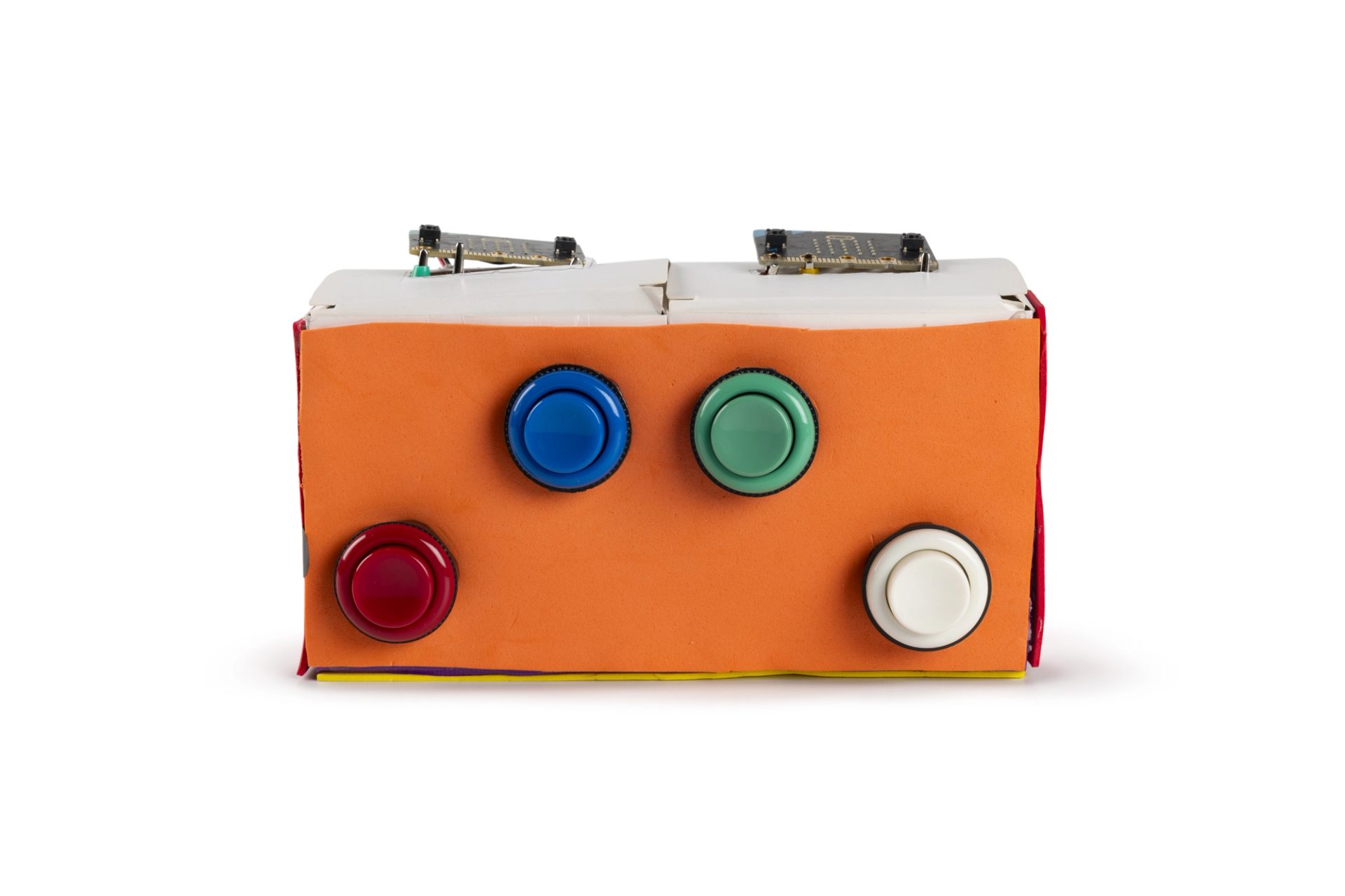
Senior Support Box
This is what we have created! It is called the Senior Support Box and it helps elderly users remember the tasks they need to do each day. On the side it shows the instructions and what each button is a reminder for. When a button is clicked it will send a signal to the MicroBit and the MicroBit will read out the task the user has to do and when they have to do it.

The Key to See
Our project, The Key to See helps solve the problem of helping elderly people be able to read. Our main driving question is: How can we make reading accessible to elderly people? Our solution to this very diverse question is creating a device to transmit, receive and display writing. This product was produced by coding two MicroBits to be a transmitter and a receiver which was decorated with cardboard. The device works by using the radio system from the two MicroBits to display the writing “Type on from keyboard”. In addition, the MicroBit is also able to beep morse code to provide the user with another option of communication. We created this by coding beats into the MicroBit to play out loud.
Merrylands High School
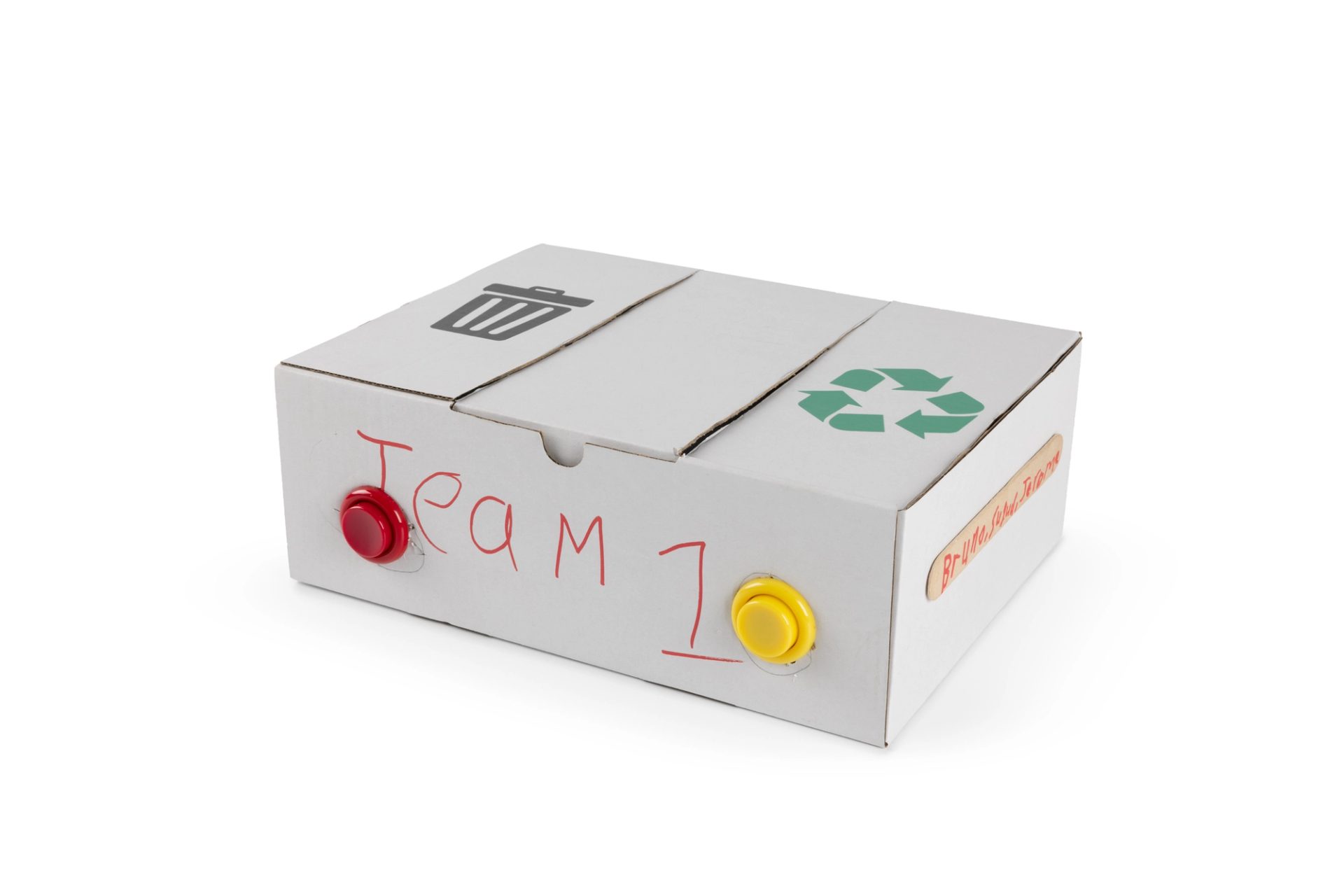
Double-Sided Bin
The problem we are trying to solve is ‘How might we reduce food waste in our community?’ Our project is a two-sided bin with one side for recycling and one side for general waste. Each side has a button connected to a motor and the bin will open when you press the button. As a small group, we had some issues with timing, but we showed our resilience in finishing the project.
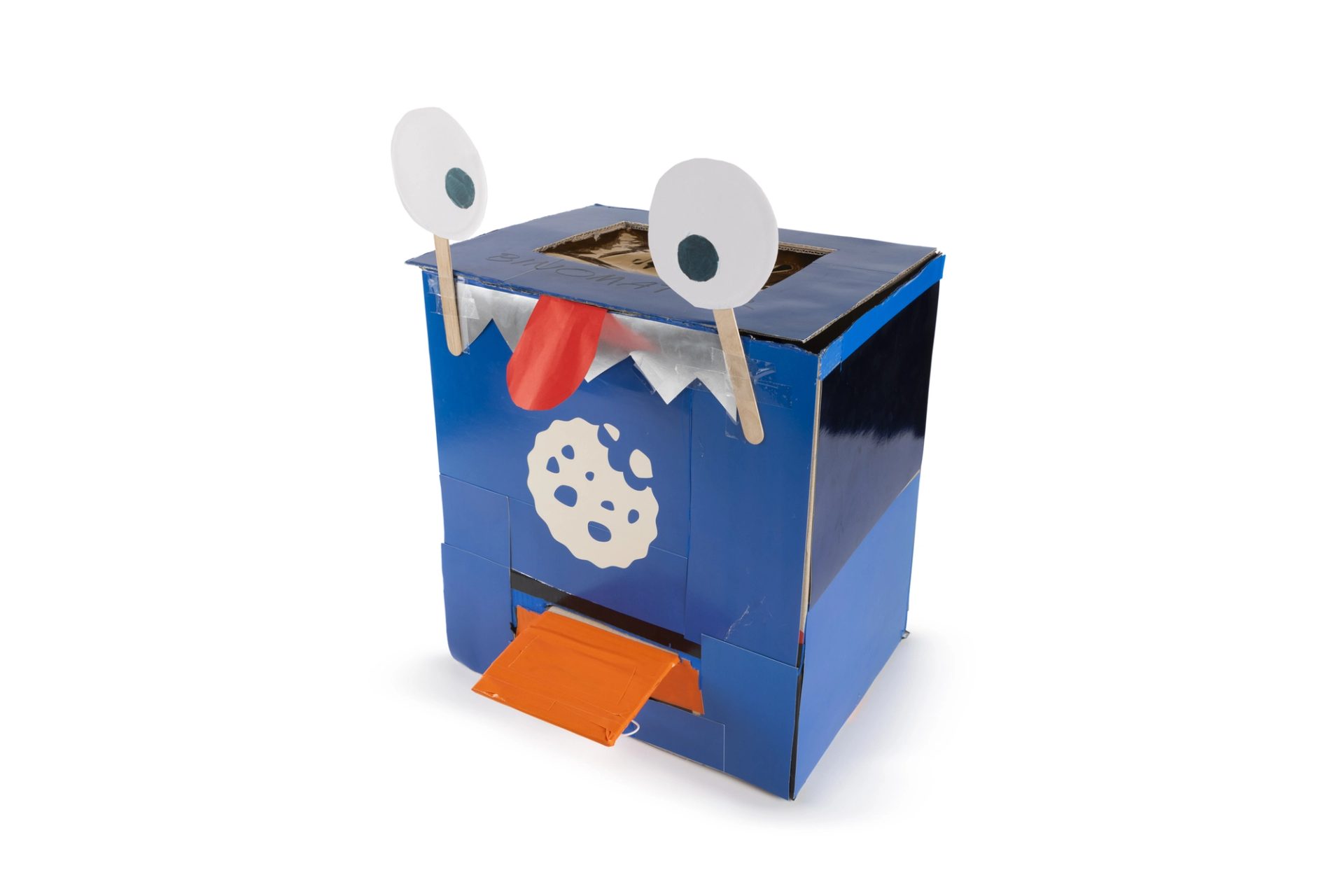
Binomator
The Binomator is designed to help the everyday user reduce water in the community. The Binomator contains a Micro:bit connected to a button, a motor and a sensor. The lid automatically opens upon pressing on the pedal and what the light sensor should do is detect whether the bin is full or not. The design we chose was inspired by Sesame St with the character Cookie Monster – hence the blue. Coding the Binomator was more difficult than building it.
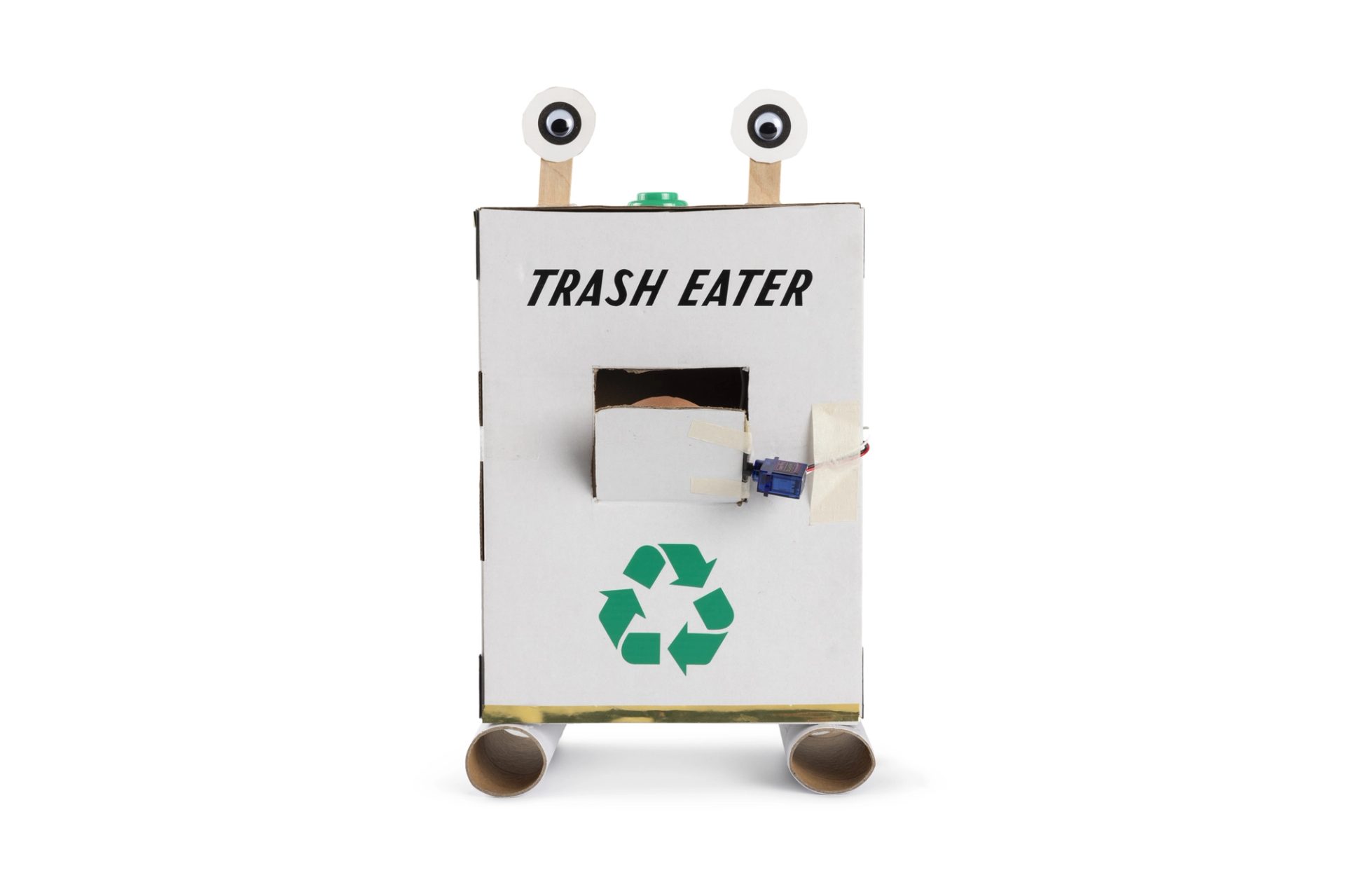
Trash Eater
We wanted to help people to reduce the amount of waste in their working space. Our project is a trash bin, called the Trash Eater, with a green button on top of the box. Pressing the button then opens the little box in the middle. The little box opens for 15 seconds, then it will close by itself. The purpose of this creation is a desk rubbish bin to make it easier for people to put their rubbish in the bin.
Oran Park High School

Might Master Morpher (MMM)
The three M is the latest project by our company. It is a sleek and modern handheld device that assures the safety of the elders of your community. Our question was ‘How might we help the elderly in our community?’ Do your parents or grandparents ever get lost? Fear no more because of the 3M. When your grandparents go for a walk, they take the triple M with them. Say they get lost, with a click of a button, the triple M sends a signal to the receiver. They will then receive directions from an in-built 8-rose compass. Fear no more!
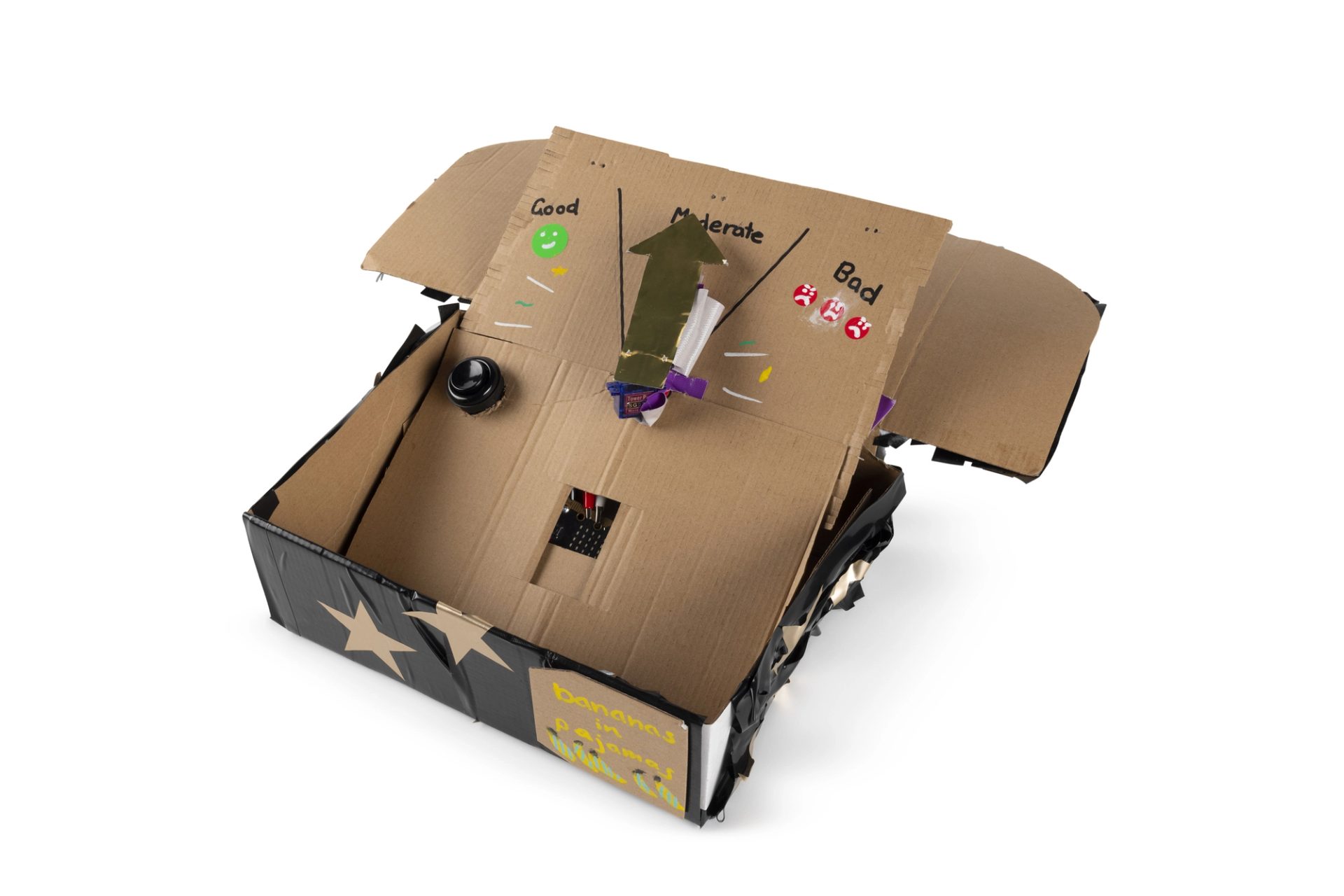
The Classroom Noise Manager
Our project, The Classroom Noise Manager (TCNM) can detect noise in classrooms and also make noise itself. It displays an emoji to alert the teacher of the excessive noise in the classroom. This allows the class to reduce their noise and continue learning. Often teachers are not able to control students during class which hinders students’ abilities to learn and listen in class. Our project alerts the teacher of the noise and can only be turned off by pressing the button.
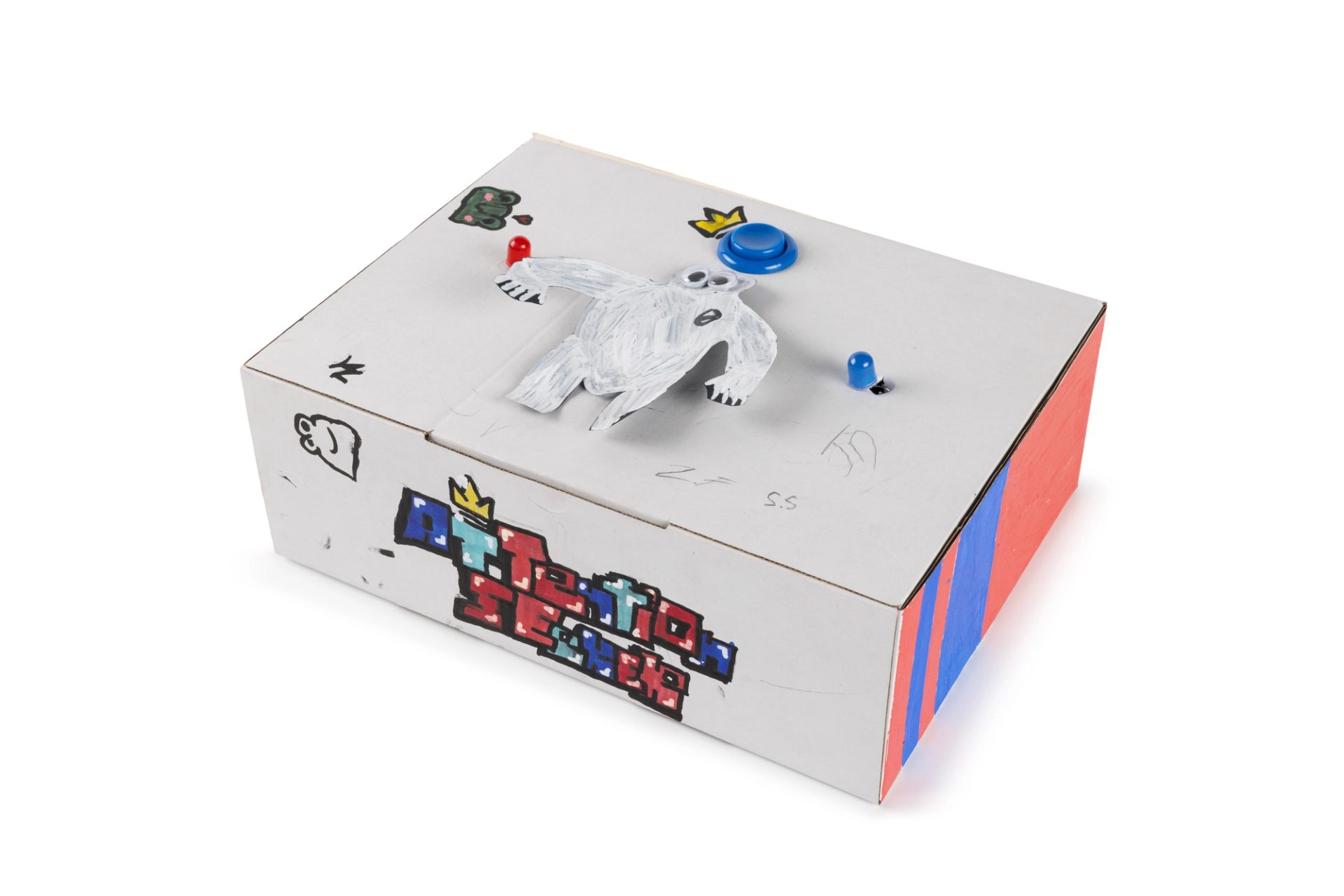
The Attention Seeker
The Attention Seeker is a product specially engineered towards the elderly people of your community. It includes a MicroBit, a red and blue LED, an arcade button and a built-in speaker. The Attention Seeker is used as an alert, which notifies you where the person in need of help is via speaker and red and blue LEDs. It’s useful for people with disabilities, as with one press, the Attention Seeker will activate its amazing LEDs. The attention seeker comes with a senior discount of 30% and its price is very low at only $15 without the discount.
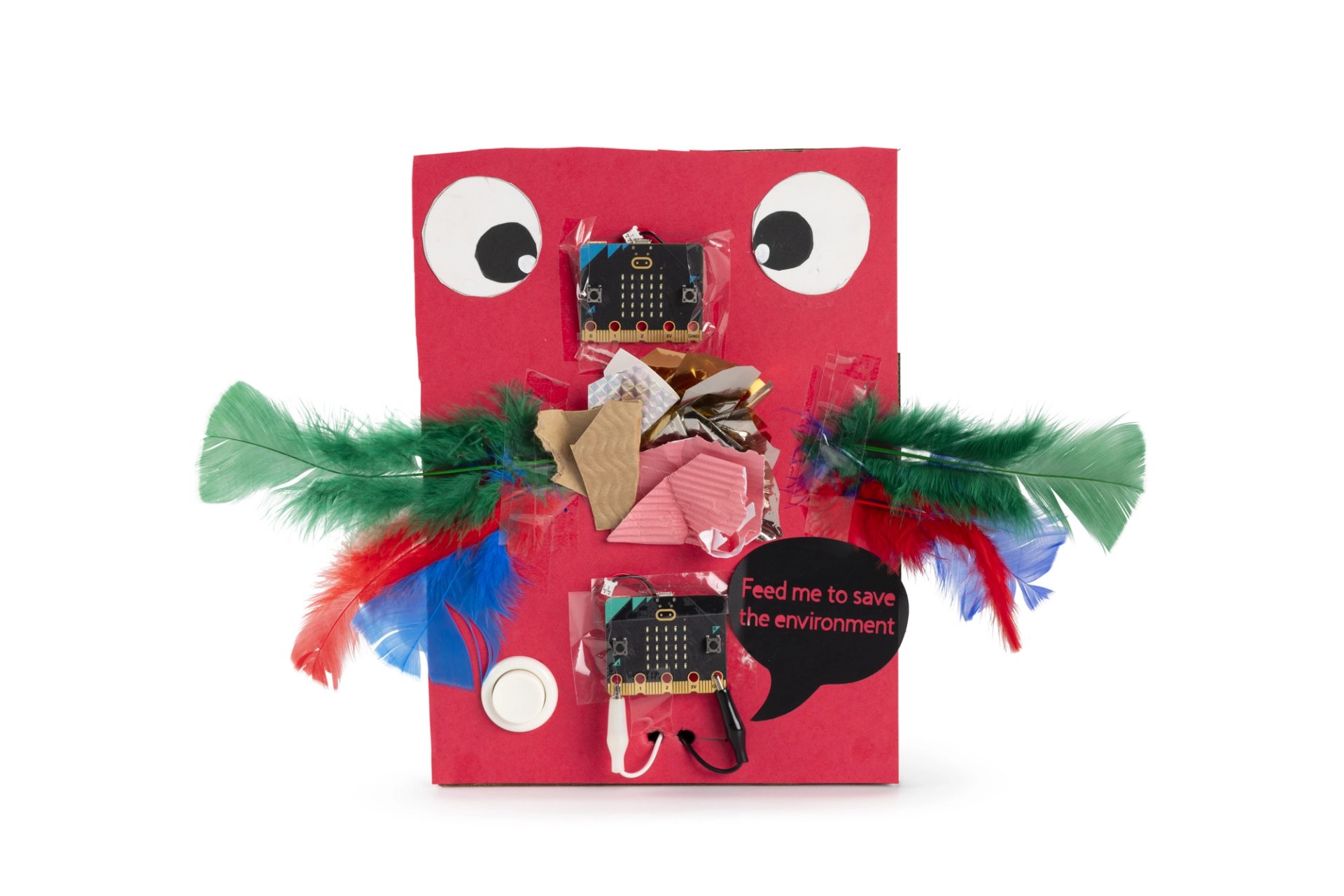
The Trash Parrot
The Trash Parrot is a modified bin targeted to young primary school students to reduce waste, using child friendly aspects. It takes the form of a parrot so that children recycle. The Trash Parrot has a friendly design with fluffy, colourful feathers and cute, detailed eyes. There is a hole designated at an area to insert the rubbish, as well as the parrot’s mouth, essentially feeding it. There is a button that plays music to make it more appealing to children, as well as a screen that displays a graph of the classes who have put the most rubbish in the bin. In addition, there is a small reward of 10c taken out from the side of the bin, enabling kids to understand the value of money. Solution – it will encourage kids to throw rubbish in the bin rather than the playground. After all, kids are the solution to the world.
Barramurra Public School

Trash Cat
The problem we were trying to solve is ‘How might we reduce rubbish in our community?’ We came up with Trash Cat. Trash Cat is a cat shaped bin that you put your rubbish in. When it receives the rubbish, you get a token, which is a house point system at our school. The house with the most points gets a reward. We used technology to solve our rubbish problem. It will solve our problem by motivating students to throw away all their rubbish. That’s all about our...TRASH CAT.
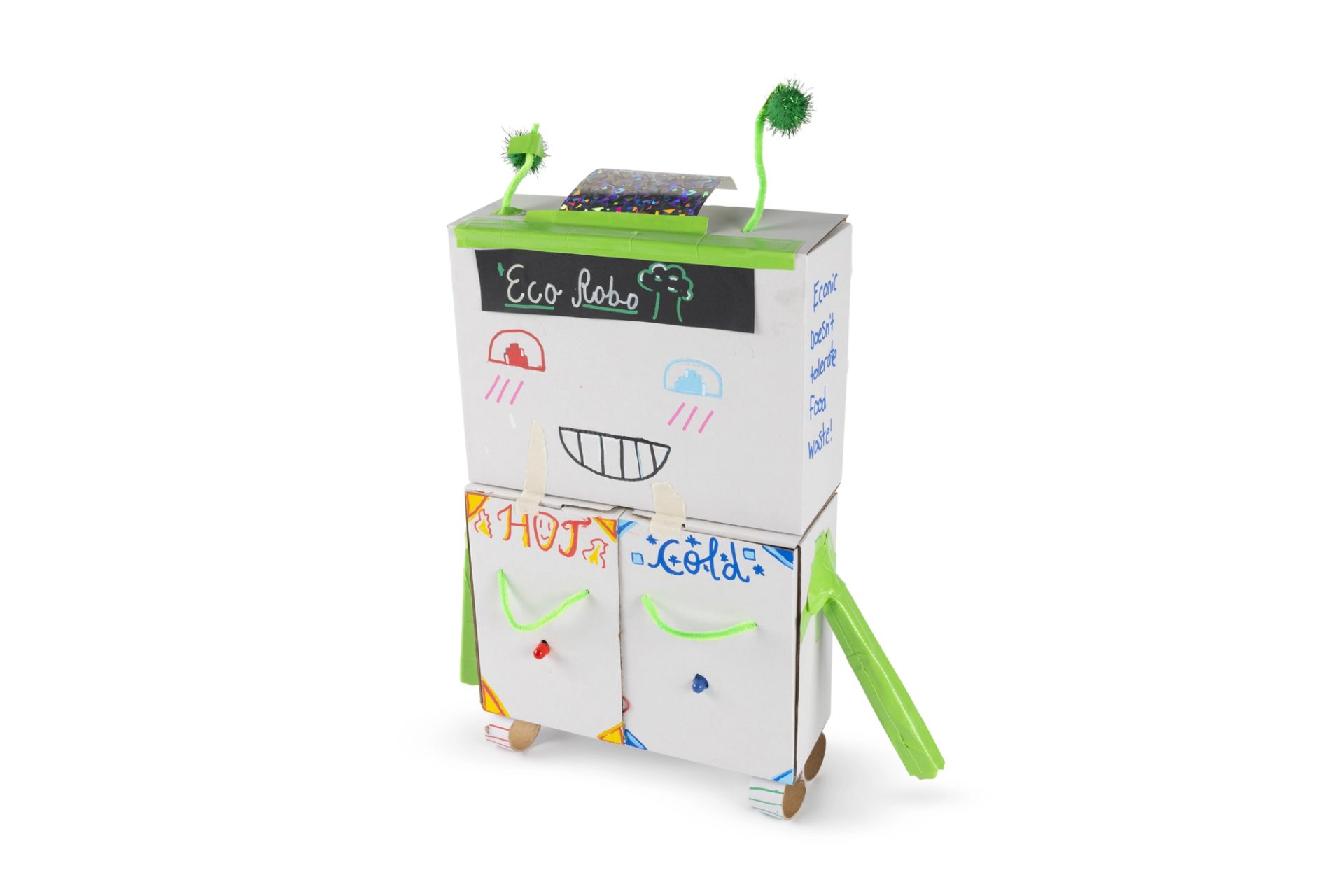
EcoRobo
EcoRobo is an invention designed to answer the question of how we might use food waste to help people in our community. EcoRobo is a robot that can interpret signals to give food to people in need which would otherwise be wasted. There is a hot section and cold section to reheat or keep food cool during the trip to the people in need. The robot has a solar panel on top to help save electricity.
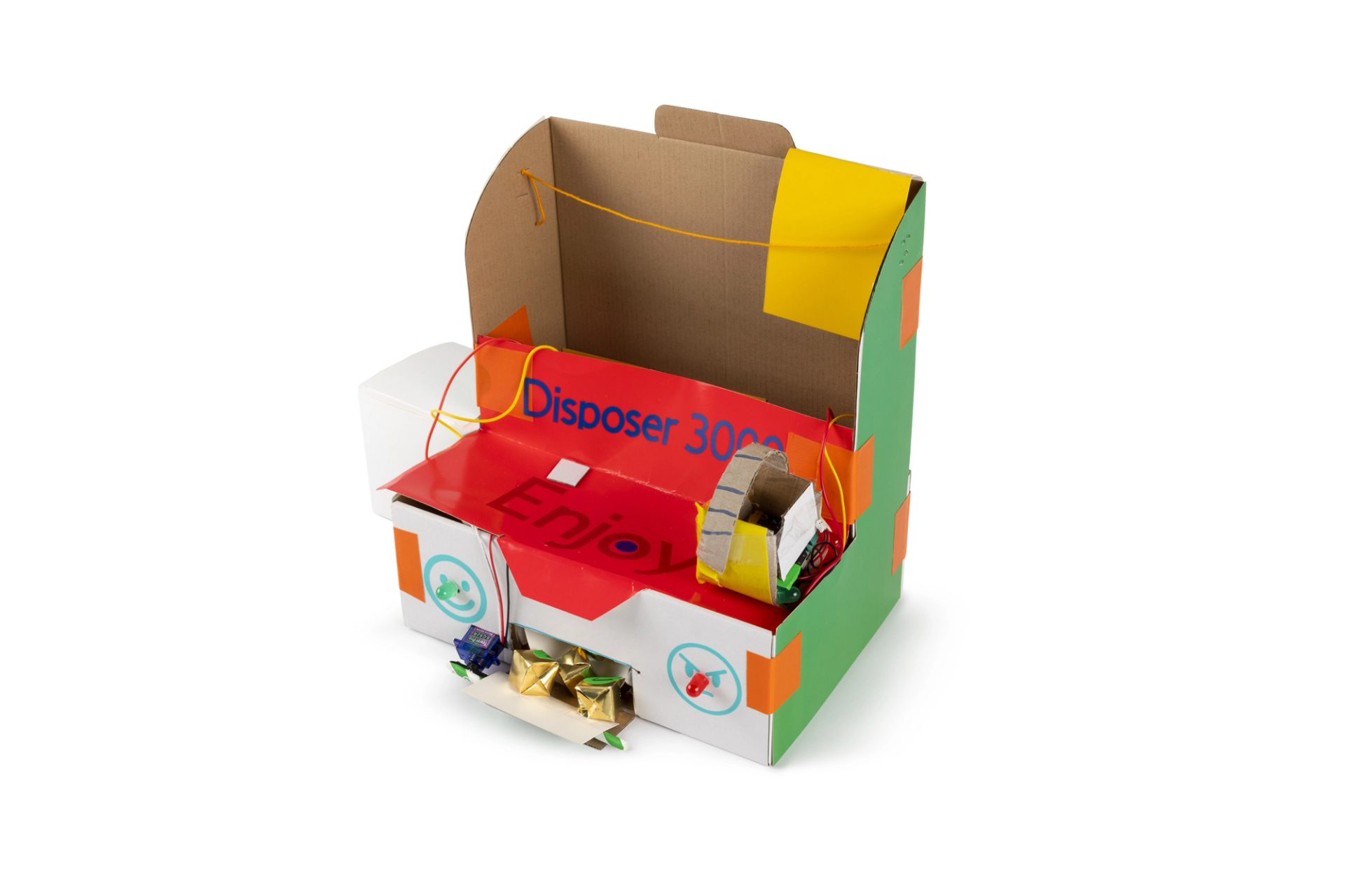
Disposer 3000
The question we asked ourselves was ‘How might we make people enjoy not littering?’ The name of our project is the Disposer 3000. The Disposer 3000 is an extremely high-tech bin that gives you tokens when you put rubbish in. This means that people enjoy putting garbage into the bin. We used a motor, lights, Micro:bits and some alligator pins. We also used stickers, tokens and a cardboard box to decorate the bin.
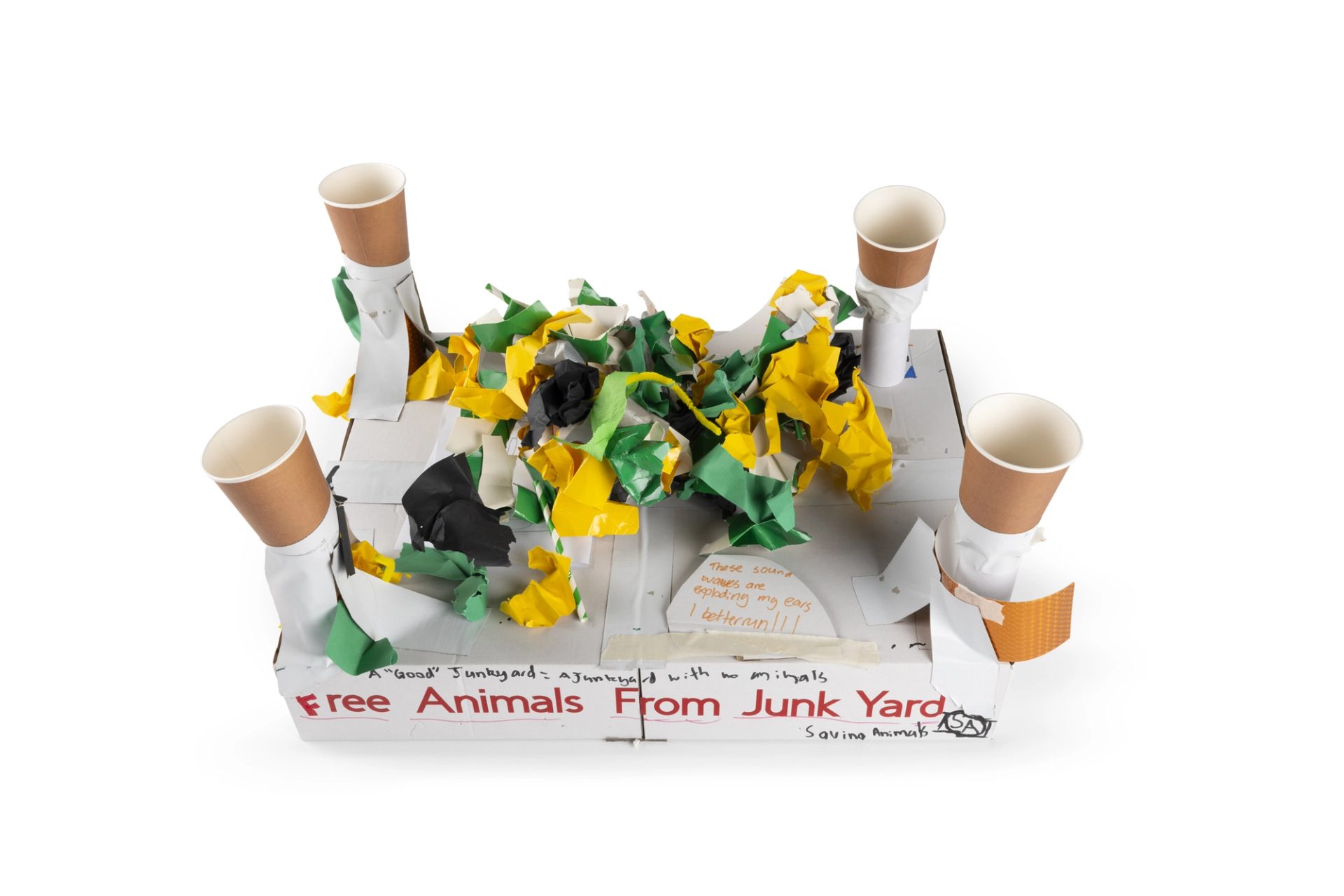
The Junkyard Project
Finally, the moment we have been waiting for, when animals don’t die from being trapped in junkyards. This is the Junkyard Project. The pillars are transmitting sound throughout the junkyard to force animals out and stop them from entering. Our question was ‘How might we keep animals away from junkyards?’ Our project represents a tiny scale model junkyard. The two Micro:bits we used are emitting a sound that repels all forms of wildlife, protecting animals from eating and getting tangled in plastic.
Kingswood High School

Jak Mars
The project we have made to solve our problem of littering due to laziness, is based on collecting school house points each time someone puts their rubbish in the bin. The Jak Mars is made with an array of materials, including cardboard, wires, buttons, the Micro:bit and more, to show our idea to others. With the disposal of your rubbish and a press of the button, the Micro:bit thanks you and counts your points for your designated house. With our prototype, this gives students more motivation and pride in throwing their rubbish in the bin.
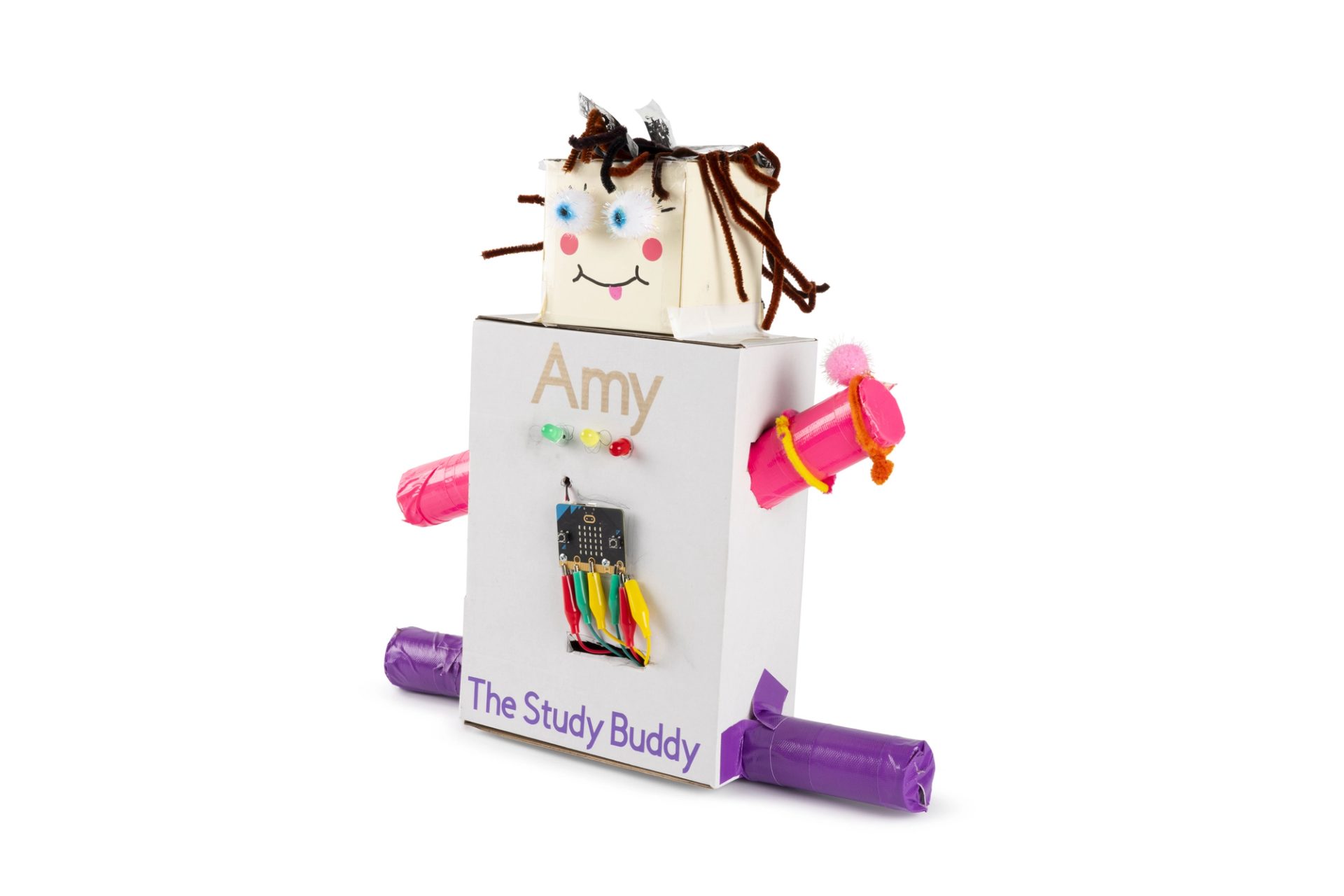
Amy the Study Buddy
As students, we and other children often face the frustrating problem of time management skills when working on exams and assignments. This is why we invented Amy the Study Buddy. The three lights represent the time until your task is due. The ‘B’ button cycles through the lights. Green means 1 week left, yellow 3 days and red 1 day. Our original plan was to use timers, but we can’t demonstrate them now. The problem this solves is that students lack time management skills. Amy helps them maintain time and allows them to complete their assignment on time by reminding them to complete their work.
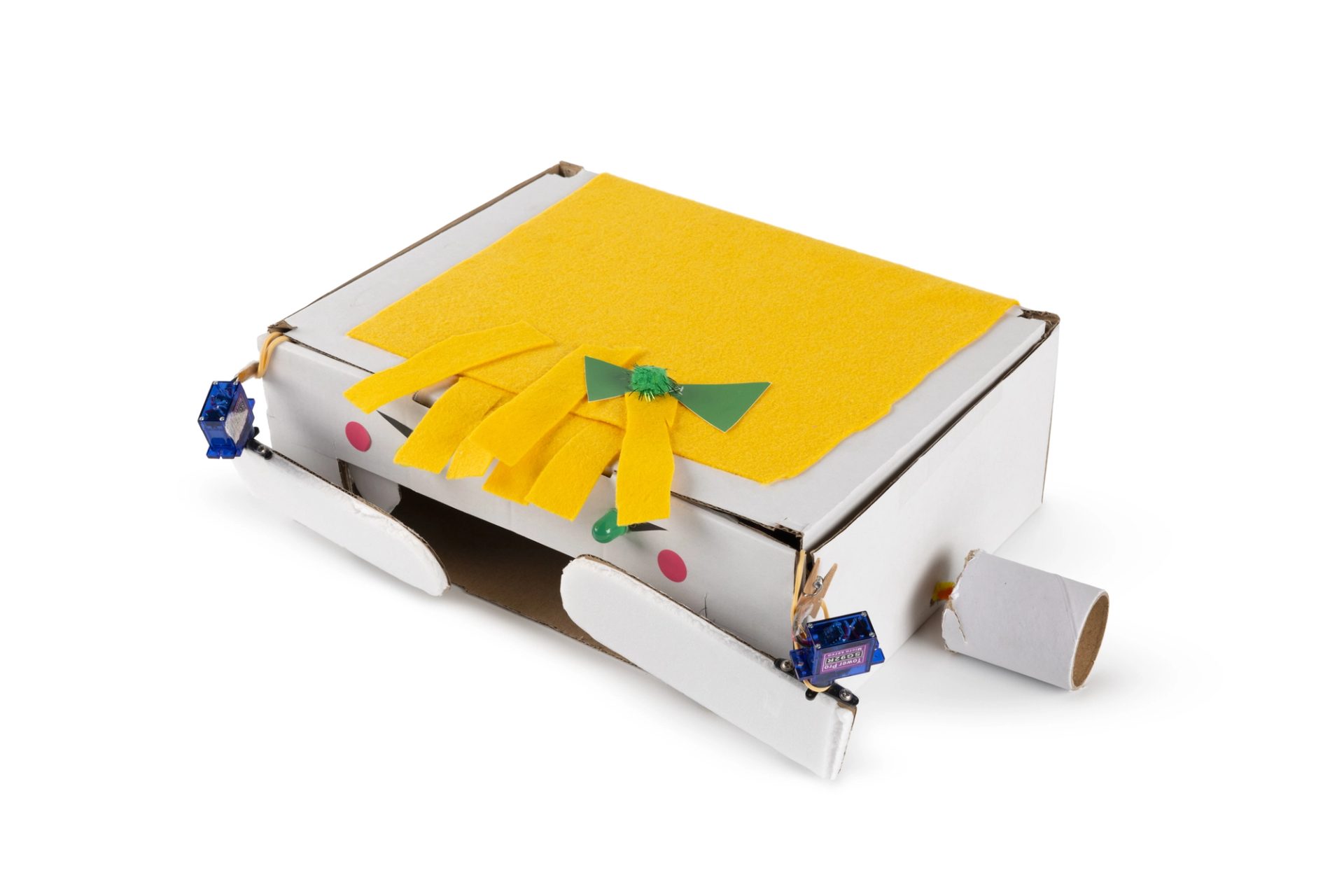
Patrasha
Our project Patrasha is designed to help young children clean away their mess. We built this because it has become too normalised that young children are littering and are not knowledgeable about the environment. We introduced Patrasha to get them used to the idea of recycling and throwing trash into the correct bin. This can also help parents struggling with a mess after taking care of their children. Patrasha works using a remote to control the motor arms that sweep trash away and eyes that light up.

Guide Paw
The question we wanted to solve was ‘How might we help an elderly person who has sight or hearing impairments?’ To help solve this question we made the Guide Paw. Our project is designed to help elderly people who have hearing and visual impairment/difficulties do the simple task of crossing the road. It hears the pedestrian crossing noise (beeping) and makes the LEDs flash, which alerts the user that it is clear to cross. This helps solve our problem as now, even if you have hearing or visual difficulties, you can perform this task independently.
Kingsgrove North High School

The Claw
Our group has created a project that can help the elderly. Some elderly people sometimes struggle to open a jar, but we have come up with a solution – The Claw. The Claw helps to open jars that might be screwed on tightly. Our project has been coded with a Micro:bit to make the machine open the jar. The Claw is made on top of a cardboard box with wires installed inside. When you look up further in the claw, you see the motor making the popsicle move up and down when you press the yellow button. By pressing the button, the jar is opened without any technical difficulties.
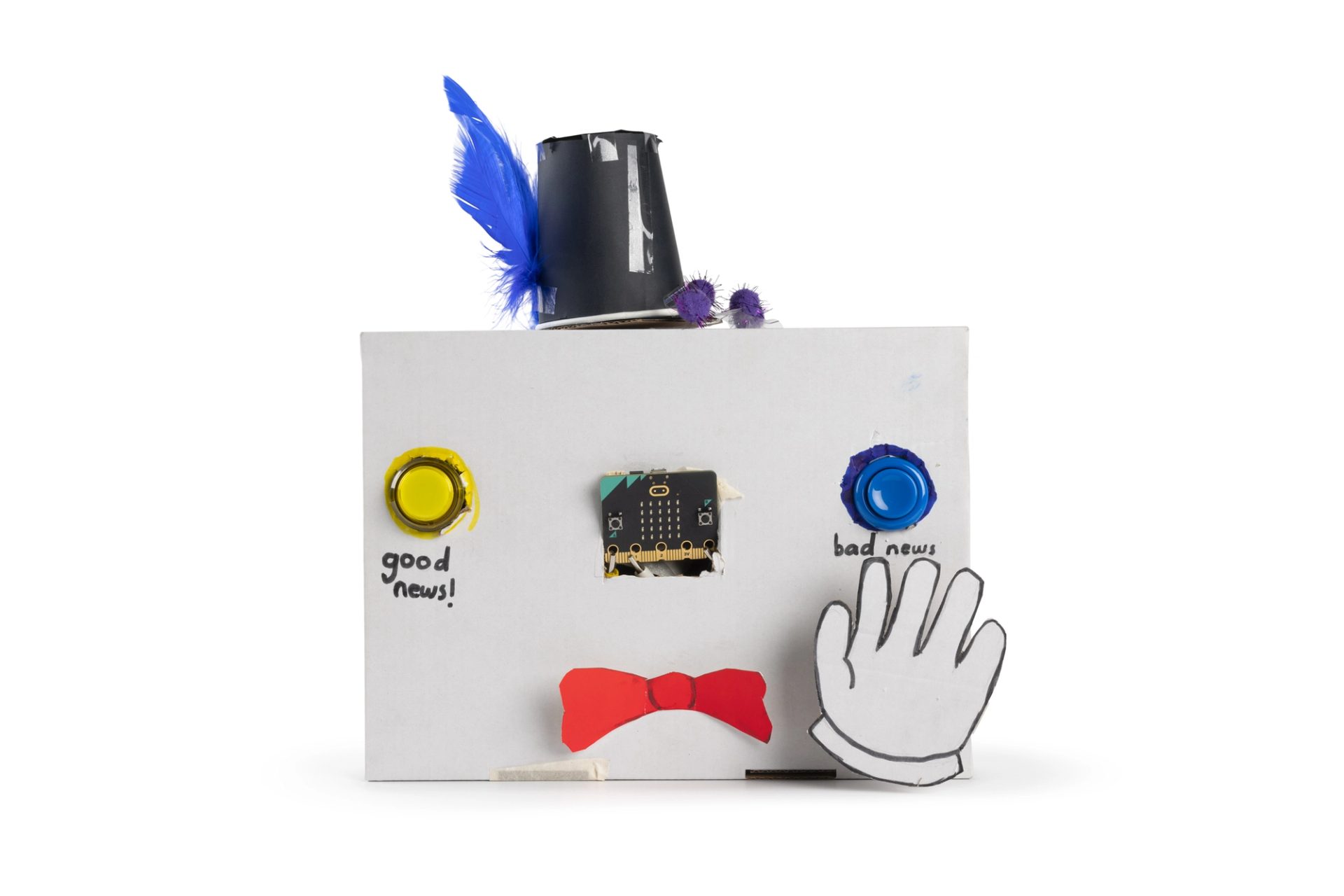
Oscar the Friendly Bot
Oscar the Friendly Bot is a program designed to help loneliness in the elderly community. Oscar started with the question ‘How might we help the elderly feel more understood and heard?’ Oscar has two buttons. When the yellow button is pressed, it smiles. This is used when an elderly person has good news. The blue button is pressed when an elderly person has bad news and it displays a sad face. The yellow button scrolls text that says ‘that’s great’ and the blue button says ‘you got this’. Oscar solves loneliness by helping the elderly feel more heard. It helps people who have no one to talk to feel understood by acting as a robotic best friend.

Math-I-Fun
We have created a fun and easy way to learn. With this creation, your child can practice their maths skills at home. The Math-I-Fun will display a question for you on the screen (true or false). If you think the answer is false, click the red button twice. If you think it is true, press the green button twice. If you succeed in answering the question correctly the game will give a reward of coins. The parents will be given a key once it is unpackaged, and they can choose the reward. They can refill it through the side of the top. Once you acquire 10 coins, hand them over to your parents and they will give you your reward.
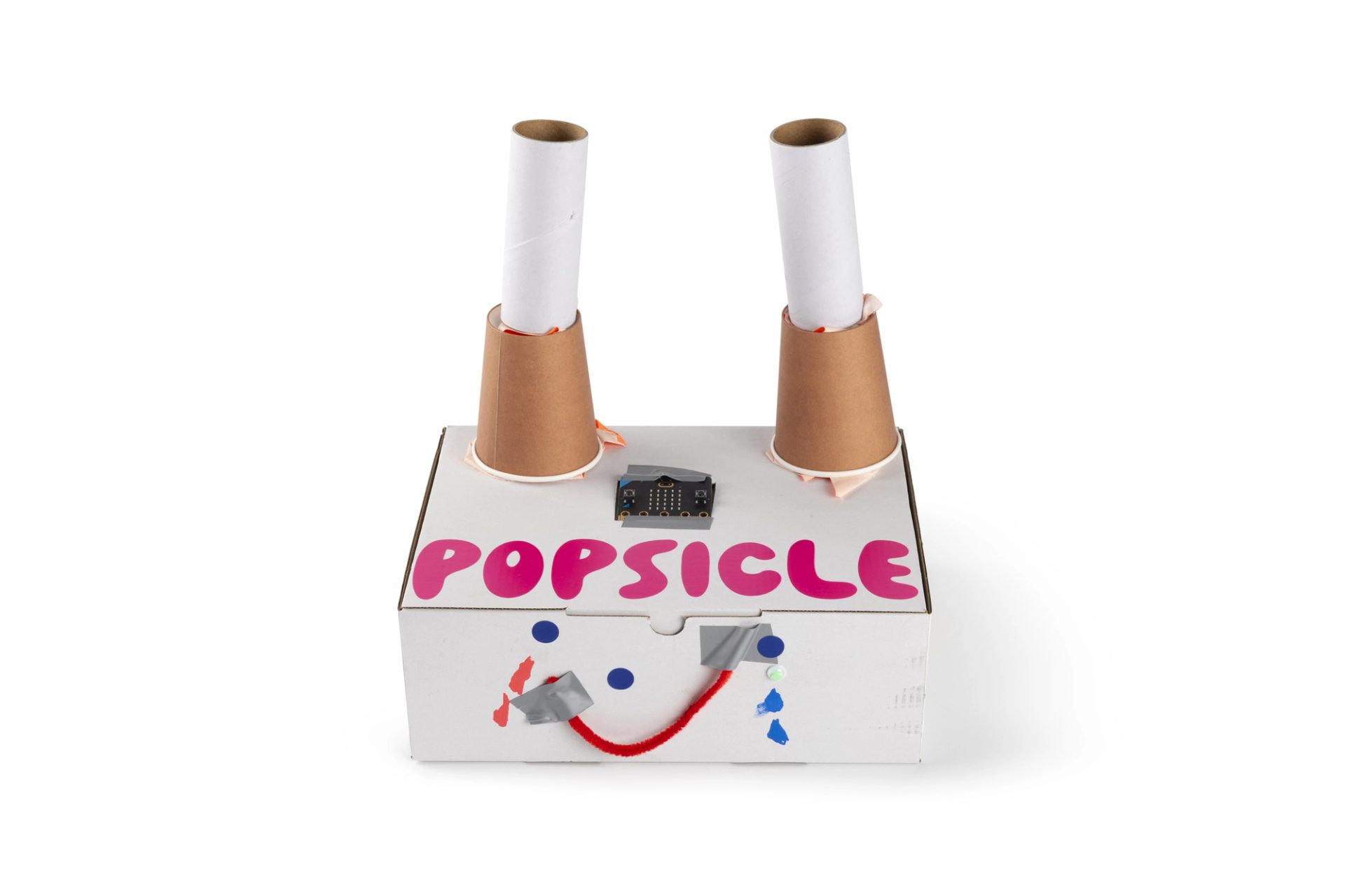
Popsicle
The problem we were trying to solve was ‘How might we help elderly people to stay safe in potentially dangerous areas such as busy roads?’ The name of our project is Popsicle and it is a happy box to help the elderly. Our box will receive radio signals from various places where Micro:bits have been placed. When a signal is received, it will signal this with an icon that can be changed if you know how to code. Popsicle is made with two Micro:bits connected using the radio function.











